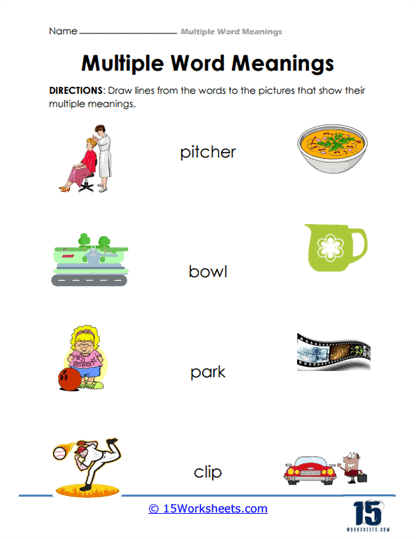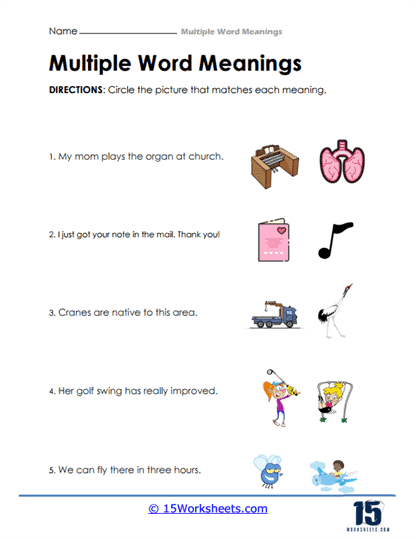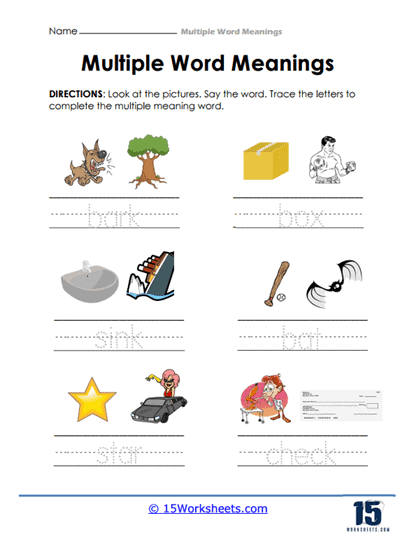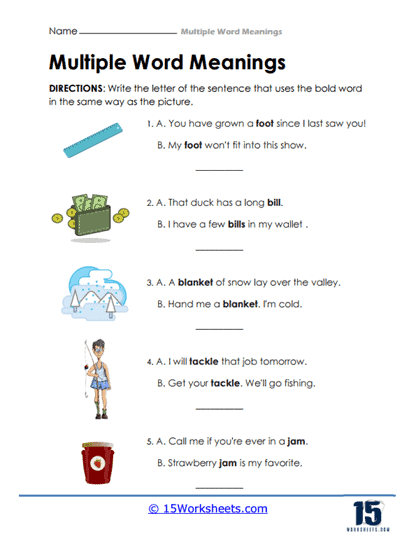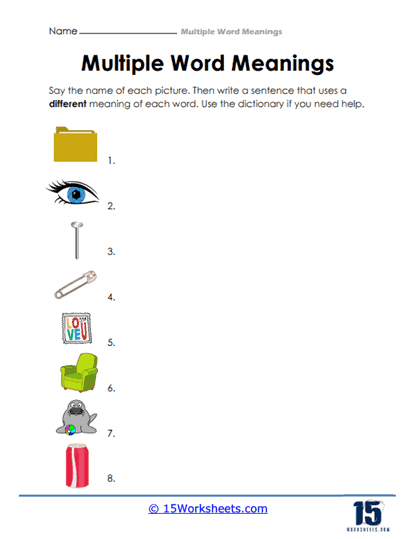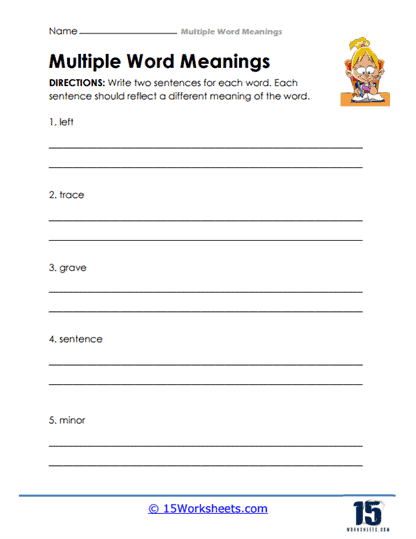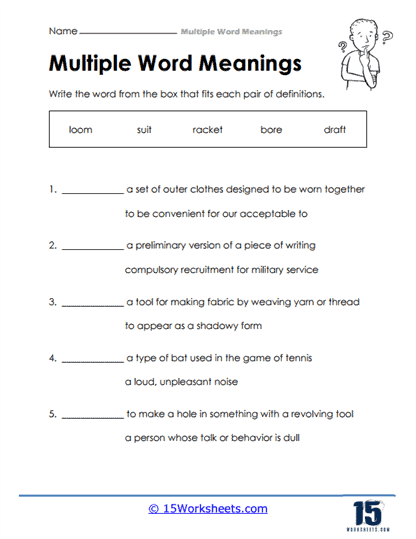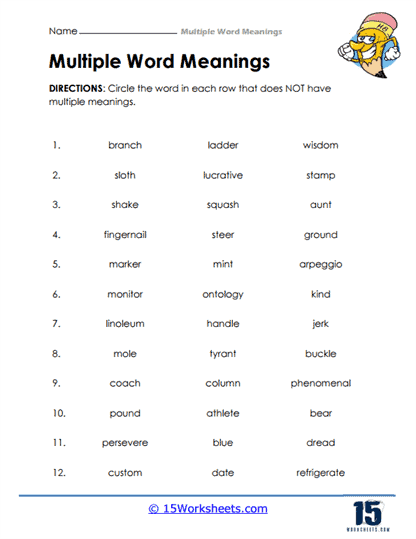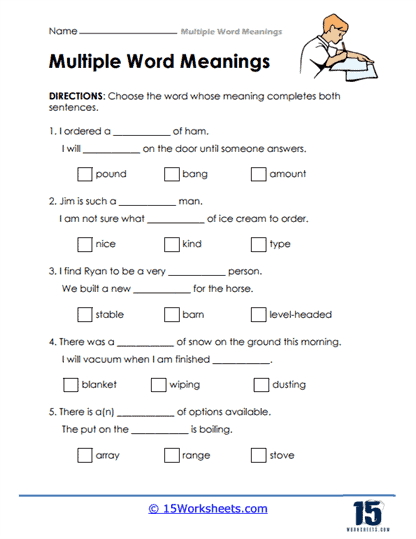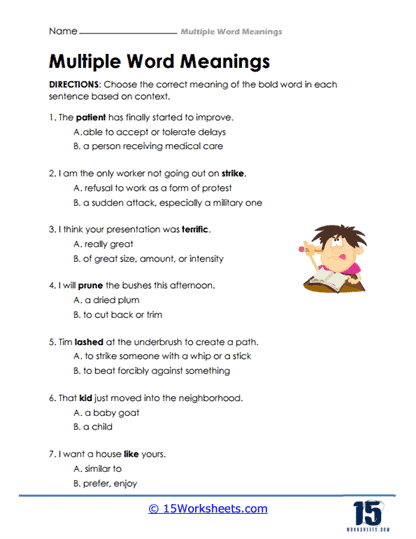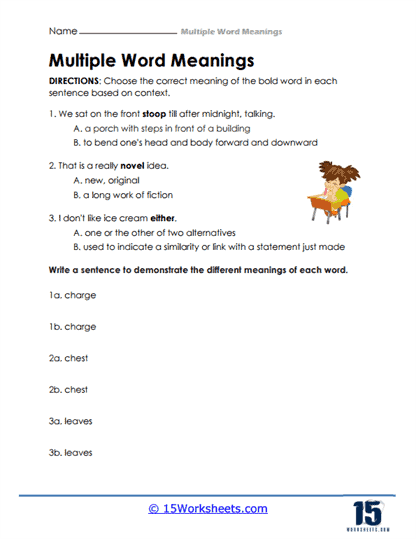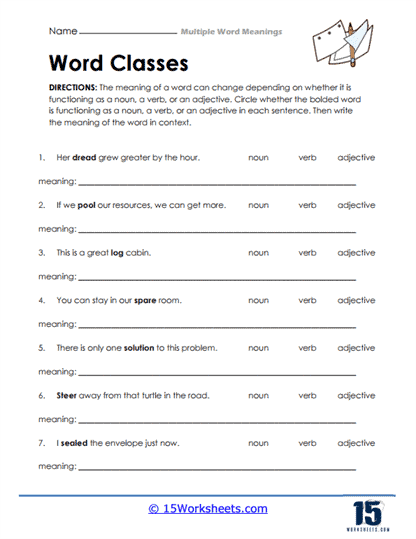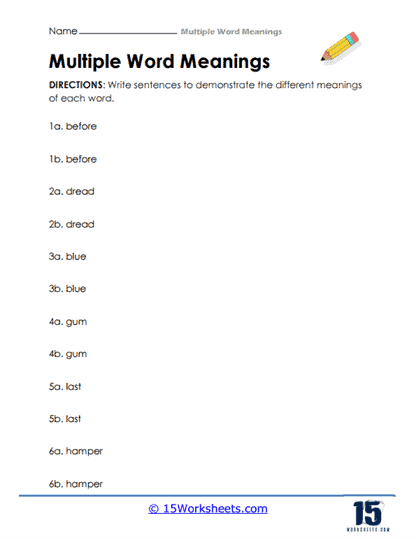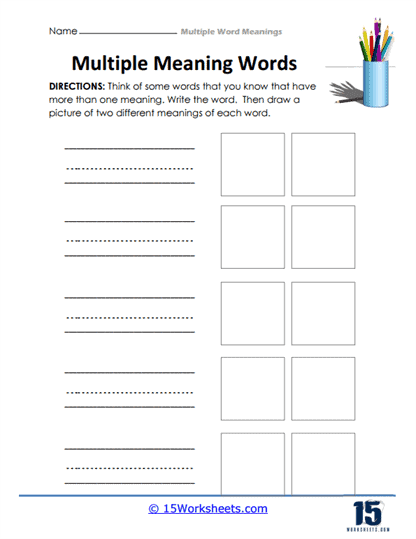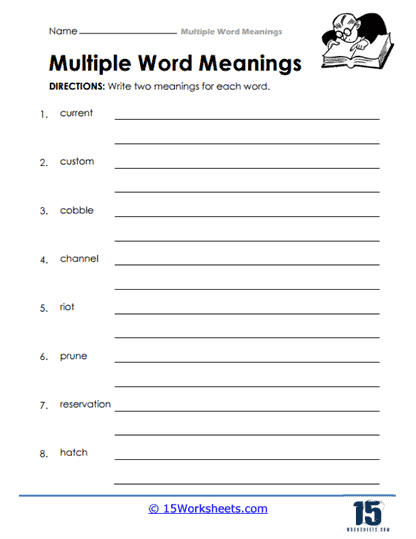Multiple Word Meanings Worksheets
All About These 15 Worksheets
This comprehensive collection of 15 worksheets on multiple word meanings provides students with an enriching and interactive way to explore the complexities of language. Words often carry more than one meaning, and understanding these nuances is essential for effective communication. These worksheets are thoughtfully designed to guide students through the process of identifying, interpreting, and using words that have multiple meanings, helping them to develop a deeper and more sophisticated grasp of vocabulary. Through a variety of carefully crafted activities and exercises, students will not only expand their vocabulary but also sharpen their critical thinking and language comprehension skills.
The activities included in these worksheets take a multifaceted approach to learning. One of the key features is the use of pictures as visual cues, enabling students to connect images with words that have more than one meaning. This technique helps students see how the same word can evoke different ideas depending on its context. By visually matching words with their varying meanings, students can internalize the concept that language is dynamic, and that context often dictates how a word should be interpreted. This visual association lays the groundwork for students to begin recognizing and understanding these words in real-life situations.
Another core element of these worksheets is the tracing of words that possess multiple meanings. This exercise reinforces the recognition of such words in written form, which can help students identify them more easily when encountered in texts. By actively engaging with these words, students not only learn to recognize their forms but also to understand their diverse uses. Tracing exercises also aid in reinforcing memory retention, ensuring that students can recall and apply these words more readily in both spoken and written communication.
The worksheets also challenge students to construct their own sentences using words that have multiple meanings. This task goes beyond passive recognition and encourages students to actively apply their knowledge in creative ways. By crafting sentences where the meaning of a word shifts based on context, students demonstrate their ability to think critically about language and to use words flexibly. This exercise is particularly valuable because it requires students to consider how word meanings can change depending on the situation, fostering a deeper appreciation for the subtleties of communication.
Students will be asked to provide definitions for words that have multiple meanings. This task promotes an analytical approach to vocabulary as it requires students to reflect on how a single word can serve different purposes in various contexts. Defining words in multiple ways pushes students to think beyond surface-level meanings and engage with language at a more nuanced level. By practicing this skill, students gain confidence in their ability to decipher and interpret language in diverse settings, whether in literature, conversation, or academic writing.
The creative element of drawing pictures to represent different meanings of the same word offers a fun yet educational way for students to visualize abstract language concepts. By illustrating how a single word can take on different meanings, students engage with language in a tangible way that enhances both comprehension and retention. This artistic component encourages creativity and allows students to express their understanding in ways that go beyond traditional writing exercises, catering to different learning styles and making the learning process more enjoyable.
This series of worksheets is designed to encourage students to engage deeply with the intricacies of language and develop a more nuanced understanding of vocabulary. The activities emphasize the importance of context, critical thinking, and creativity in navigating words with multiple meanings. As students work through these exercises, they will not only expand their vocabulary and reading comprehension but also gain confidence in their ability to use language effectively. By fostering a greater appreciation for the richness and flexibility of words, these worksheets provide a solid foundation for students to become more articulate, thoughtful, and effective communicators.
Why Do English Words Have Multiple Meanings?
The English language, with its vast lexicon and intricate history, is renowned for its richness and versatility. One of the most fascinating aspects of English is the phenomenon of polysemy-the capacity of a single word to bear multiple meanings. This complexity is not accidental; rather, it arises from a combination of historical, cultural, and linguistic factors that have shaped English over centuries. Understanding why words in English can have multiple meanings offers insight into the dynamic nature of the language and its ability to adapt to ever-changing social and technological landscapes.
Historical Development of Language
The history of English is one of continuous evolution, stretching back more than a millennium. Over time, the meanings of words have shifted, expanded, and transformed. Often, a word retains an older, more traditional meaning while simultaneously adopting new interpretations that reflect the needs and realities of the society using it. For instance, technological advancements or shifts in cultural values frequently demand the invention of new terms, yet the language often adapts existing words instead. Words like “cell,” once used exclusively to refer to a small, enclosed space (such as a prison cell or a monastery chamber), now also describe biological units and even mobile devices. This evolution demonstrates the resilience and adaptability of the language in accommodating new ideas without discarding older concepts. Through this layering of meanings, English becomes a living archive of its past, while remaining highly relevant to the present.
Influence of Borrowing from Other Languages
Another critical reason why English words often have multiple meanings is its historical tendency to borrow extensively from other languages. English is a linguistic melting pot, having absorbed vocabulary from Latin, Greek, French, German, and many others over the centuries. These borrowings frequently result in words that carry their original meanings into English while simultaneously being shaped by the particular needs and nuances of English-speaking societies. A word like “restaurant,” for example, borrowed from French, retains its meaning as an eating establishment, but in English, it has also acquired regional and cultural connotations that expand its use in various contexts. This blending of meanings creates a rich tapestry of linguistic expression, allowing a single word to evoke multiple images or ideas depending on the context in which it is used.
The Power of Semantic Shifts
Words are not static; they are in a constant state of flux. One of the most fascinating linguistic processes that leads to multiple meanings is semantic shift, where a word’s meaning changes over time. Often, this shift occurs as a result of metaphorical or metonymic usage. Take, for instance, the word “mouse.” Historically, this word referred only to the small rodent, but with the rise of computing technology, “mouse” now also denotes a device used to navigate a computer. This shift exemplifies how societal and technological changes can reconfigure the meanings of words, embedding them with new significance while retaining their older senses. This kind of expansion allows language to stay relevant, but it also creates a delightful complexity for speakers and writers who must navigate these shifting meanings in communication.
Flexibility and Productivity in Word Formation
The flexibility of English as a language is another key factor behind the proliferation of multiple meanings. English has a remarkable capacity to generate new words and meanings through processes such as compounding, derivation, and conversion. A single word can be used as both a noun and a verb, with meanings that diverge yet remain connected by the core idea. Take the word “run,” for instance. It can refer to the physical act of moving quickly on foot (verb), the act of operating something (as in “run a business”), or even the experience of something continuing for a period of time (as in “a successful run in the theater”). This linguistic productivity allows speakers to apply existing vocabulary to new contexts without needing to invent entirely new words, resulting in a language that is not only efficient but also exceptionally creative.
Contextual Influences on Meaning
One of the most powerful forces shaping the meaning of words is context. The meaning of a word often depends on the specific situation or field in which it is used. A single word can carry vastly different connotations depending on whether it is employed in a formal, informal, or technical setting. For example, the word “field” might refer to a physical area of land when discussing agriculture, a specialized area of study in academia, or even a specific part of a software program in computing. This contextual adaptability is a hallmark of English, enabling speakers to communicate complex ideas efficiently by tailoring the meaning of words to fit various scenarios. Rather than being a drawback, this versatility enhances the expressiveness of the language, allowing for subtle shifts in meaning that enrich communication.
Homonyms and Homophones: Adding Complexity and Playfulness
Adding another layer of complexity are homonyms and homophones-words that are either spelled the same (homonyms) or pronounced the same (homophones) but have different meanings. Consider the word “bat,” which can refer to a piece of sports equipment used in baseball or a nocturnal flying mammal. Although these meanings are entirely unrelated, they coexist within the same word, adding to the polysemy of English. Similarly, homophones like “flower” and “flour” sound identical but have completely different meanings and spellings. While these linguistic quirks can sometimes lead to confusion, they also provide opportunities for creativity, such as in puns or poetic wordplay, further enriching the English language.
A Language of Depth and Richness
While the presence of multiple meanings for a single word can occasionally lead to ambiguity or misunderstanding, it is also a testament to the depth and richness of English. Polysemy allows for a greater range of expression, giving speakers the tools to convey complex ideas in nuanced ways. It encourages adaptability, helping the language evolve alongside cultural, social, and technological shifts. Mastering the use of words with multiple meanings is not only a linguistic skill but also a gateway to appreciating the historical and creative dimensions of the language. This multiplicity makes English not just a functional tool for communication, but a vibrant and ever-evolving system that reflects the complexity of human experience itself.

